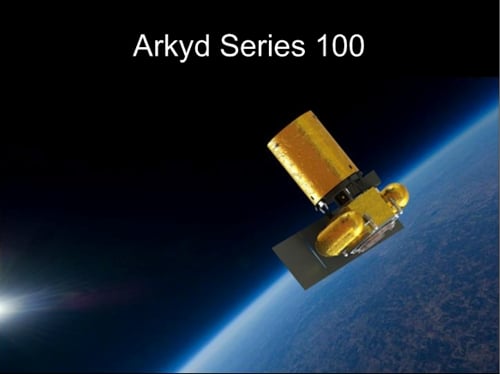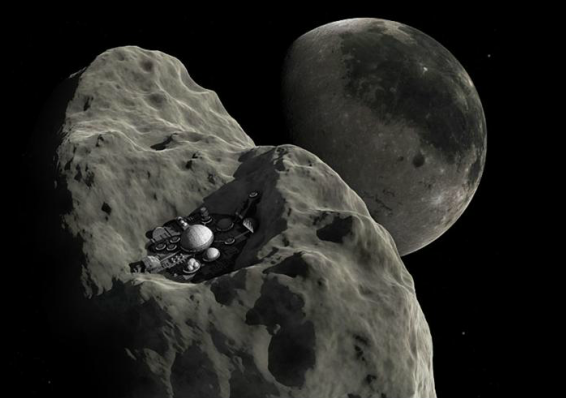Original URL: https://www.theregister.com/2012/04/25/asteroid_mining_uncertain/
Billionaire astro mining venture long on hype and timescale
First launch in 2014, mining in 2022
Posted in Science, 25th April 2012 00:32 GMT
The much-hyped launch of Planetary Resources has been held in the august surroundings of the Museum of Flight in Seattle; so now we've got some details how feasible are the plans?
According to the roadmap laid out the first phase of the project will kick off with the launch of the Arkyd Series 100 spacecraft, which is basically a near-Earth orbit telescope designed to scout out likely asteroids for mining. The timeframe given for this is 2014, and the spacecraft is small enough to be launched as a secondary payload for a larger launch.
The Series 100, which has no internal propulsion systems, will have a broad spectrum camera and will include a manipulator arm to allow pictures of itself to be taken, and will test out some of the communications technologies needed, as well as the craft's ability to work as part of a team with other units.

The Arkyd 100, due for orbit by 2014
Around 2016 Planetary Resources sees its Series 200 craft getting out of the gravity well. These will include a propulsion system and be tasked with scouting out for incoming asteroids that look interesting. It will also serve as a test bed for multi-unit coordination in scanning and mapping techniques.
The Series 300 system will come after this, and those will be devoted to actually landing on the asteroids and starting the gritty business of mining by 2022.
"This is smart money investing in one of the largest commercial opportunities ever - going to space to gain resources for the benefit of humanity," said cofounder Peter Diamandis. "The Earth is feeling a resource pinch and ultimately we have the ability to turn that which is scarce into abundance."
So far, so good, and the team obviously have the first designs ready to go. One interesting facet of the press conference was about the design philosophy for the venture's space vehicles. These won't be one-off craft, like those carefully assembled and shot into space by NASA. Planetary Resources envisages an assembly line system for building the devices, which will slash build time, lower costs and thus reduce the repercussions of system failures.
Such a system, coupled with some of the advances we're seeing from companies like SpaceX in bringing down the cost of getting into orbit, should make for a more cost effective mission, but it's a long way to go before the company achieves its aim of launching asteroid probe missions for the few million dollars it has set as a goal.
What the press launch today didn't say was what could be done to asteroids when they got there. Sure, there were some flashy graphics about robotic refineries and one graphic showing an entire asteroid being enveloped in a shell, but this kind of stuff is more in the annals of science fiction than based on current technology.

Some mining plans stray into fantasy
Cofounder Eric Anderson mentioned that similar systems were being set up by Shell and others on the sea floor for deep sea oil mining, and there have been some major successes in this area. But there's a world of difference between trying this approach on Earth and out in space, particularly as the whole plan is to make the entire operation robotic.
The two areas the group is concentrating on are water and platinum group metals. Water isn't going to be too hard to process. There are plenty of 'wet' asteroids up there with a high water content contained in relatively friable rocks, and this can be released by heating the fragments and then distilling off the water. Water's not only useful for drinking, but also for breaking down into rocket fuel, and the team envisages solar system refueling dumps being set up that could reduce the cost of exploration.
It's a nice idea, but the devil is in the details. For a start you'd need a refueling system that actually works, and the power to crack the water into its respective hydrogen and oxygen and then convert that into rocket fuel beforehand. It's a tricky and dangerous process here on Earth – and the hurdles only get bigger out in space and without human operators.
With metals mining there are even greater challenges. As was rightly pointed out, there's a colossal amount of rare and needed minerals out there just floating around, but mining them will be a tricky business. We don’t know the ore quality that's likely to be found, and while mining it won't be too tough, particularly on rubble asteroids, refining it could well be.

Refinery awaits the boys from the Dwarf
Even supposing this could be achieved, you've then got the problems of returning the finished materials back to Earth and down the gravity well. Shifting chunks of pure platinum into Earth orbit shouldn't be too tough, provided a propulsion system can do it economically and reliably. Getting it back down the gravity well would also be doable, if slightly expensive.
But surely this doesn't matter? After all, platinum is fabulously expensive and the team suggested that one asteroid could generate more of the stuff than has ever been mined in Earth's history. This is true, up to a point,but once the operation gets going the price of platinum may fall drastically, particularly when the market makers realize what's heading into orbit.
This isn’t new in history. When Spain acquired its South American colonies the driving force for exploration was precious metals. Christopher Columbus and his ilk would encourage Native Americans for find gold by cutting off body parts if they didn't bring in a certain amount – which makes a bollocking from the boss these days much easier to handle, no pun intended.
Massive mines soon began to bring in more gold and silver than the Spanish knew what to do with. This contributed greatly to rampant inflation across Europe, and saddled the Spanish state, then one of the most powerful in Europe, with economic problems that crippled the economy for some time - arguably right up to the present day.
This is unlikely to happen with Planetary Resources' plans, but given the nature of the market the returns are not necessarily going to be as big as some might hope. The price of platinum is already volatile, and you might expect the floor to drop out of the market once the first mining ship returns to orbit.
But before you think this is going to be an endless series of knocking the plan, here's why it might be expected to work, albeit not in a way that most people expect. Expanding out into the Solar System is coming; it has to. We're already stretching the bounds of what the planet will support as it is and global population hasn't peaked yet. We need the resources floating in space to survive and expand.

All currently available resources on this blue dot
The Planetary Resources team is quite frank about the fact it expects to have multiple failures along the way, and may in fact be superseded by other ventures doing the same thing. Key investor Charles Simonyi said as much on Tuesday, comparing this to the initial internet bubble. Some investors lost money and some made it, but society benefited as a whole.
It may be that many of the big names on this are quite willing to lose money on the whole deal, if it kick-starts an industry that could be the making of mankind. It would be nice if they did make the returns, but they may not be too sorry if Planetary Resources fails and some other corporation, or organization, with a better business plan, makes it work.
It would also be interesting to know whether the wealthy merchants, landowners and royals behind the likes of the Hudson's Bay Company or the East India Company felt the same way. ®